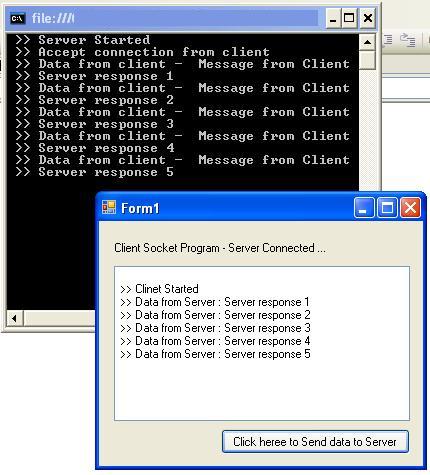Socket Programming in VB.net
By: Issac in VB.net Tutorials on 2009-02-21
A Socket is an End-Point of to and From (Bidirectional) communication link between two programs (Server Program and Client Program) running on the network. We need A Server Socket Program (Server) and a Client Socket Program (Client); for running a socket program.
Server Program: A Server Socket Program running on a computer has a socket that bound to a Port Number on that computer which is listening to the client's requests.
Client Program: A client Socket Program has to know the IP Address (Hostname) of the computer that the Server Socket Program resides and the Port Number assign for listening for client's request.

Once the connection is established, the Server and Client can read or write their own sockets.
There are two types of communication protocols which we can use for Socket programming; they are TCP/IP (Transmission Control Protocol/Internet protocol) Communication and UDP/IP (User Datagram Protocol/Internet protocol) Communication.
In the following section we are going to connect a Server Socket Program and Client Socket Program through VB.NET code using TCP/IP Communication.

In the above picture shows the communication interfaces.
Server Socket Program:
Here Server Socket Program is done through a Console based VB.NET application. The Server listens for the client's request, and when it gets a request from the Client, it sends a response to Client.
Client Socket Program:
The Client Socket Program is a window based application and when it starts it gets connected to the server and sends requests, and also receives the response from Server.
Let's see how to run this program? The Socket Programming has two sections.
- Server Socket Program
- Client Socket Program
When you finish coding the program, first you have to run the Server Socket program; once it is started you will get the DOS screen with a message Server Started.
Next start the Client Socket Program. Then you will get message in client screen Client Started, at the same time check the server screen you will get a message as Accept connection from client.
Now the Server Socket Program and Client Socket Program get connected. If you click the button (Click here to send data to Server) in client window, and then you can see changes in Server and Client screen messages.
Add Comment
This policy contains information about your privacy. By posting, you are declaring that you understand this policy:
- Your name, rating, website address, town, country, state and comment will be publicly displayed if entered.
- Aside from the data entered into these form fields, other stored data about your comment will include:
- Your IP address (not displayed)
- The time/date of your submission (displayed)
- Your email address will not be shared. It is collected for only two reasons:
- Administrative purposes, should a need to contact you arise.
- To inform you of new comments, should you subscribe to receive notifications.
- A cookie may be set on your computer. This is used to remember your inputs. It will expire by itself.
This policy is subject to change at any time and without notice.
These terms and conditions contain rules about posting comments. By submitting a comment, you are declaring that you agree with these rules:
- Although the administrator will attempt to moderate comments, it is impossible for every comment to have been moderated at any given time.
- You acknowledge that all comments express the views and opinions of the original author and not those of the administrator.
- You agree not to post any material which is knowingly false, obscene, hateful, threatening, harassing or invasive of a person's privacy.
- The administrator has the right to edit, move or remove any comment for any reason and without notice.
Failure to comply with these rules may result in being banned from submitting further comments.
These terms and conditions are subject to change at any time and without notice.
- Data Science
- Android
- React Native
- AJAX
- ASP.net
- C
- C++
- C#
- Cocoa
- Cloud Computing
- HTML5
- Java
- Javascript
- JSF
- JSP
- J2ME
- Java Beans
- EJB
- JDBC
- Linux
- Mac OS X
- iPhone
- MySQL
- Office 365
- Perl
- PHP
- Python
- Ruby
- VB.net
- Hibernate
- Struts
- SAP
- Trends
- Tech Reviews
- WebServices
- XML
- Certification
- Interview
categories
Related Tutorials
Changes in Controls from VB6 to VB.net
Unstructured Exception Handling in VB.net
Structured Exception Handling in VB.net
Creating Sub Procedures in VB.net
Passing a Variable Number of Arguments to Procedures in VB.net
Specifying Optional Arguments with default values in Procedures in VB.net
Preserving a Variable's Values between Procedure Calls in VB.net
Throwing an Exception in VB.net
Comments